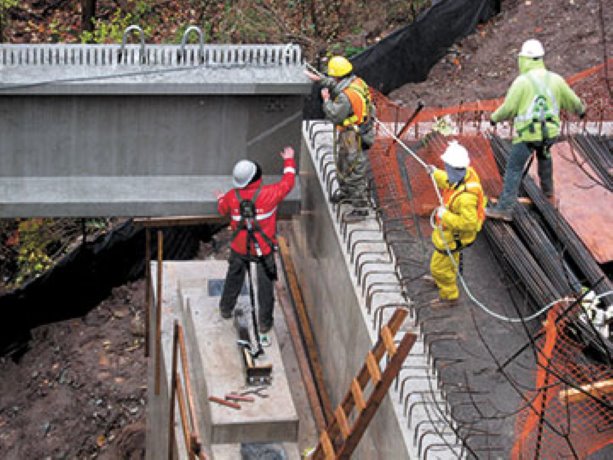Four long-disused, 90-year-old-plus concrete bridge piers are being put back into service as part of an overall $27-million watermain project to strengthen security of water supply service in the west Oakville/east Burlington area.
Ten 32-metre-long, 1.4-metre deep and 1.2-metre-wide prestressed concrete girders spanning the piers will support a still-to-be- built cast-in place 200-mm-thick concrete platform which will carry a 900-mm-diameter concrete pressure watermain. Munro Ltd. was the fabricator of both the watermain and the girders.
But six of those girders had to be hoisted over the deep Bronte Creek Valley on one of the rainiest days the Greater Toronto Area experienced in all of 2012.
The Saturday Oct. 27 day-long lift occurred on the same weekend the edges of Hurricane Sandy started to buffet the region.
Earlier in the week, four of the 10 girders had been installed by Varcon Construction. The six remaining ones had to be erected that weekend, says Don Hull, senior contract administrator with R. V.Anderson Associates Ltd., the consultant for Halton Region.
Two 600-ton rented cranes used for the lift were booked to be at other project sites the following week, he explains.
“Because of the weather and the need to stabilize one of the machines in the wet ground, the first lift didn’t start until 4.30 pm and the last one at 10 that night.”
Two of the 44,000-kilogram girders had to be lifted directly over the water and that required the careful coordinated use of both cranes, one of which was in the valley and other on Dundas Street above. Tied-down workers on the piers guided the girders into place, says Hull.
At about 4 a.m. on Sunday, the crane on Dundas Street was disassembled and ready for transport. That allowed for the reopening of two traffic lanes which had been closed for the project. By 2 p.m. that afternoon, the second crane had left the site, he says.
The 1919 piers and a west abutment are all that remain of an original Dundas Street bridge constructed between 1917 and 1919 and then demolished for a new bridge in 1948.
“We’re not sure why,” says Jacqueline Weston, the region’s manager of water design and construction when asked how and why the piers remained intact when so many structures of that era were demolished in the post Second World War boom of the 1950s and 1960s.
But an environmental assessment study conducted by the R.V. Anderson concluded using the piers to transport the watermain was the most desirable option for crossing the valley, she says.
“We did look at tunnelling or carrying it on the (1948) bridge and there are a number of examples of where that has been done.”
At the same time, the consultant’s study noted that the piers would have to be rehabilitated before accommodating the new girders.
Cosmetic repairs were administered by sealing cracks and chipping away the outer surfaces down to sound concrete. The chipped areas were then repaired with new reinforcing steel and concrete and a cementitious coating was then applied for aesthetics and longevity of the structures, says Weston.
The “very specialized” pier work carried out by Varcon Construction is one part of the two-phase project to install the watermain along Dundas Street from Appleby Line in Burlington to Bronte Road in Oakville, On both the east and west side of the valley open-cut construction is being used by Moretti Excavating, she says.




Recent Comments
comments for this post are closed